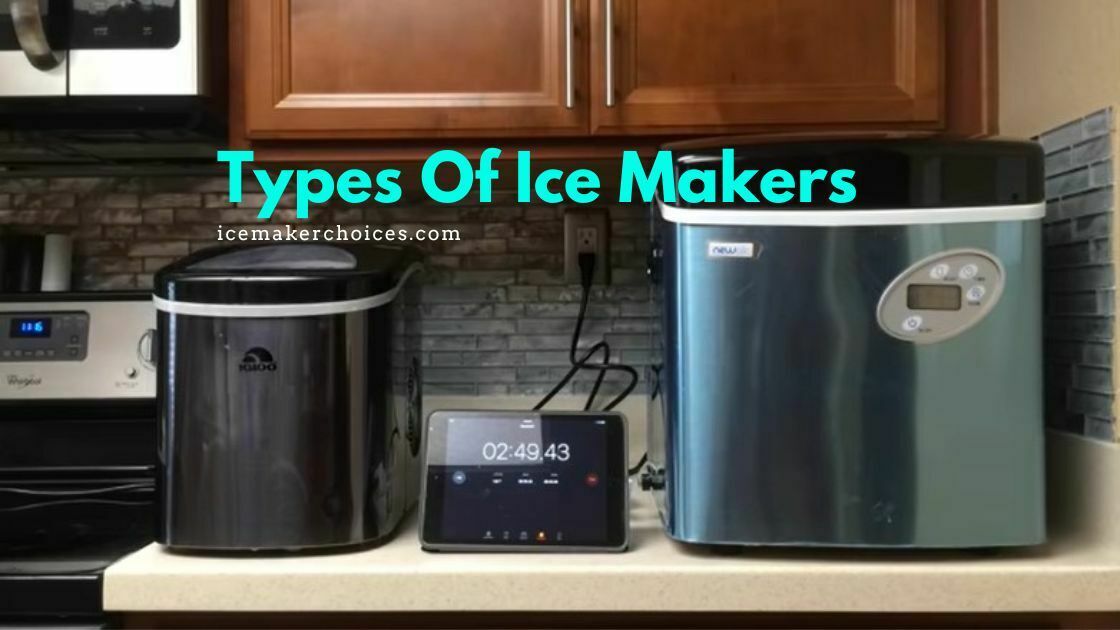Ice makes are undoubtedly a great addition to any home; they provide convenience, allowing you to make ice cubes quickly and easily, thus enabling you to enjoy refreshing beverages no matter the weather. The question is, what type is right for you? This is why today you’ll be learning all about types of ice makers.
Ice makers are essential appliances for a wide range of applications, from commercial to residential. They come in a variety of shapes and sizes, ranging from countertop ice makers to large industrial-sized machines.
With different types of ice makers on the market, it can be a daunting task to identify which one is right for you. This article will discuss the different types of ice makers available, from countertop models to built-in units, as well as their features and benefits.
From portable models that can easily fit in any kitchen or bar area to larger units designed for high-volume use, you can be certain that there is an ice maker out there that will meet your requirements perfectly.
Types Of Ice Makers Explained
In the world of ice makers, it’s easy to get confused and end up with something you might not even need; therefore it’s important to find the right one that will provide you with reliable, consistent ice production.
With the right ice maker in hand, you’ll be able to enjoy cold drinks and food any time you want. If you’re unsure which type of ice maker is right for your needs, it’s best to consult with a professional who can assess your requirements and recommend the perfect unit for you.
Below you’ll find the different types of ice makers:
Undercounter Ice Makers
Undercounter ice makers are an ideal solution for those who are looking for a more permanent, built-in solution. Boasting an insulated storage bin that accommodates 20 to 50 pounds of ice, numerous models are available on the market today.
These units are usually installed underneath the countertop, making them great for kitchens with limited space or those that want to maintain a sleek and modern look. Undercounter ice makers provide the same convenience as larger models while taking up less space.
Countertop Ice Makers
Countertop ice makers are smaller, more compact units that can easily fit on any kitchen counter or bar area. These models usually produce between 25 to 48 pounds of ice per day and come with a variety of features, such as adjustable temperature settings and automatic shut-off functions.
Countertop ice makers come in a variety of shapes and sizes to fit on your counter and produce cubes or crushed/flake-type pieces of small or large-sized cubes quickly. Some also offer filtered water options for crystal-clear cubes.
These units are usually portable, making them great for events or parties where you need plenty of cold drinks without having to wait too long for the cubes to freeze.
They’re perfect for people who don’t need a lot of ice, but still want the convenience of having fresh, crisp cubes at their fingertips.
Freestanding Ice Makers
Freestanding ice makers are larger machines that can produce large amounts of ice quickly and frequently.
These are often compared to undercounter models, with the difference that freestanding ice makers can be installed anywhere in your home instead of only fitting under a kitchen counter, which makes them a lot more versatile.
Industrial Ice Makers
Industrial or modular ice makers are larger, more powerful units that can produce upwards of 500 pounds of ice per day.
These units require a significant amount of energy and maintenance to operate properly and are often used in high-volume kitchens, bars, or other commercial establishments. They come with a variety of features designed to ensure optimal performance and durability.
Stackable Ice Makers
This efficient unit from the modular family is specifically tailored to generate a substantial amount of ice in an economical space.
If you don’t have much room for a large modular unit, stacking the units on top of one another is an efficient solution that won’t harm your ice production.
What Types of Ice Makers are Better?
The type of ice maker that is best depends on individual needs. For instance, if you need a lot of ice quickly and frequently, then a freestanding or commercial/industrial model would be the better option as these machines can produce high volumes of cubes in short periods of time.
If your needs are more modest but still want the convenience of having fresh ice quickly, then a countertop model may be more suitable for you. Stackable Ice Makers are also an efficient option if space is limited, as two or three units can be stacked on top of each other to generate plenty of ice without taking up much room.
Ultimately, it all comes down to personal preference and requirements when choosing what type of ice maker fits best for you.
How Does a Countertop Ice Maker Work?
Portable ice makers operate in a distinctive manner from their commercial counterparts. So, precisely how does one of these machines function?
Instead of inputting an ice mold with water and then waiting for it to freeze in the freezer, portable ice makers quickly produce batches of icy cubes by freezing the water directly.
The proper process would be something like this:
- The unit’s water reservoir is filled to the maximum indicated fill line for optimal use.
- By utilizing a hole at the bottom of the reservoir, water is pumped through a filter and directed to an ice tray situated atop the unit.
- As soon as the refrigeration cycle triggers, the 1/2-inch prongs on the heat exchanger become immersed in water from within an ice tray. These submerged spikes cool off at lightning speed and start to form layers of ice after a few minutes have passed.
- As soon as the ice has reached its optimal size, the tray will empty any remaining liquid into its water reservoir. Simultaneously, it is time for the heat exchanger to switch itself off and commence heating up – at a sufficient level in order for each ice cube to effortlessly fall out of its prongs and directly into an elevated storage container.
- An additional sensor placed on the ice storage basket tracks and records how much coldness is being stored, stopping the system if it gets too full.
Do The Ice Cubes Stay Frozen?
After creating the ice, it falls into a secure container or insulated bin. Despite the interior of the machine being much cooler than normal room temperature, this unit does not function as a freezer; therefore, your cubes will eventually melt over time.
How to Troubleshoot a Countertop Ice Maker?
Try to correct operational issues following the tips below:
Power supply: If your unit isn’t turning on, first check that it is properly plugged into the right voltage outlet and if a circuit breaker has been tripped.
Leaking water: If the pump is running, but no water makes it to the freeze tray or there are signs of leaking from the unit, the likely culprits could be a broken or clogged hose in its system.
Broken pump: When the water pump of an ice maker ceases to function, a lack of circulated water will obstruct its freezing process. The only reliable solution is to replace the defective pump with a new one in order for production to resume.
Not enough ice: If the ice produced is too small, it might be that the surrounding air temperature is quite hot, or else there’s not enough water being supplied. To check if this resolves your issue, utilize chilled water and monitor your results. Should you still experience difficulties with producing sufficient ice amounts, there may be a slight coolant leak reducing system performance.
Are Countertop Ice Makers Expensive?
If you want to get your hands on a countertop ice maker, then prepare yourself for some serious decisions! Prices range from $100 and up depending on the features desired.
The most basic machines will provide traditional bullet-shaped cubes in the $100 – $150 price range; for larger capacities or clear ice capabilities, look no further than an investment of around $300-$350.
What to Look for When Choosing Types Of Ice Makers
Consider the following features when choosing your ice maker machine.
Condenser Type
- Air-cooled: Air-cooled condensers, the most commonly seen type of ice machine in commercial settings, use a fan to draw air through for cooling purposes.
- Water-cooled: As the name indicates, water-cooled units contain a condenser, which is cooled down by the water. To ensure that the temperature remains stable and safe, this unit requires a steady flow of cold water to be effective.
- Remote-cooled: By utilizing this configuration, the condenser is placed in an area that’s separate from where the ice machine itself resides. Not only does this help reduce noise and heat levels within your space, but it makes remote-cooled ice machines much quieter too. The downside is these machines often require more maintenance.
Ice Size and Style
Ice size is how big the pieces of ice are from an ice maker. Some machines can make small cubes, large cubes, or even crushed/flake-type pieces. The size you choose depends on what type of drinks you want to make.
If you’re searching for the perfect ice machine, there’s no need to settle for just one size. Many machines offer a variety of sizes, from small pieces all the way up to large chunks. And if you want even more custom options? Look for a model that provides three distinct ice size choices—it may not be a common feature but it’s certainly worth investigating!
Ice Production
Ice production is how much ice an ice maker can make. Different types of ice makers can make different amounts of ice, like a countertop one that makes 25-48 pounds of ice per day or a freestanding one that makes large amounts quickly. Industrial ones are the biggest and can make up to 500 pounds per day.
Storage Capacity
It’s essential to know that this number is not related to how quickly the machine works. To uncover its maximum storage space capacity, take a look at the spec sheet.
When selecting an ice maker, the initial query to ask yourself is how much ice you will require at a single time. If it’s just a tiny amount, then maybe an appliance with a lower capacity would be better for you.
Insulation & Storage
Unlike traditional freezers, portable units don’t remain frozen. If you plan on keeping the unit running while away from home, make sure to pick a portable ice maker that recycles water back into its reservoir.
A countertop ice maker will keep your cubes ready for serving; but if not used or moved to a freezer, they’ll slowly melt over time. With the right types of ice makers, the cold water left after melting will go back into the reservoir and be used to make more ice.
Additional Features
Select types of ice makers feature a programmable timer, allowing you to set automatic start and stop times for producing the perfect amount of ice.
This not only conserves water but also ensures there are always freshly made cubes ready when needed, without having to babysit the machine.
Types Of Ice Makers Unboxing Video
In the youtube video below, we unbox and compare different types of countertop ice makers, so you can get an idea of what each has to offer.
Final Thoughts About Types Of Ice Makers
When it comes to types of ice makers, there are many features to consider. From the condenser type and size of the pieces produced, to storage capacity and insulation, researching all these factors will help you determine which model is best for your needs.
Additionally, different types of ice makers offer additional features like a timer or recycling system that can make them even more efficient in saving water and energy while producing enough cubes for any occasion. With this information in mind, selecting an ice maker machine should be much easier!



